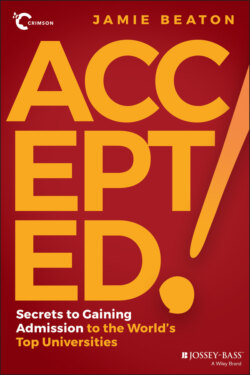Читать книгу Accepted! - Jamie Beaton - Страница 7
Introduction
ОглавлениеWhen I was 15 I bumped into my school valedictorian on a train.
It was a chance meeting, but I took the opportunity to say hello, given the guy was my academic role model and being valedictorian—or as we called it dux—at King's was on my list of high school ambitions.
We stood and chatted as the train rocked and my backpack pulled on my shoulders and bumped into the back of another book-laden kid standing behind me.
I didn't say much, mostly listened, and if you asked me now exactly what this older kid said to me, I couldn't tell you.
But what I do know is that, when I got on that train I had my future all figured out: valedictorian, high school graduation, medicine at the University of Auckland. But by the time I got off, my entire plan had been shot to pieces and replaced with another, and all because this kid told me that he had gotten into Yale.
At this stage, of course, I had no idea what I was doing.
The best plan I could come up with was this: more is definitely more. Although other kids took three A Levels, I took ten. If my peers were making Top in New Zealand, I set my sights on making Top in the World (I made it for English Literature). If my older mate managed to get into Yale applying to a handful of schools, I figured it was best to hedge my bets and increase my chances by pure volume, and so I applied to many of the world’s top universities.
Of course, no one was more surprised than I was when I got into all of the greats I applied to: Harvard, Yale, Wharton (Hunstman), Cambridge, Yale-NUS, and more! I was just a skinny kid from the bottom of the world who narrowed the odds by going overboard.
So would I do it the same way again, given what I know now, given the people I've met and the places I've studied and the questions I've asked of scores of my mentors and peers at Harvard, Stanford, and Oxford?
The answer is yes and no.
We're all told time and time again that there is no secret formula of guaranteeing a spot at an Ivy or Stanford or MIT—and that is true, but only to a point, given like any highly sought-after goal, sooner or later you start to see a pattern. I started Crimson Education with my then-girlfriend at 17, on the floor of our respective parents' living rooms, and even then, I knew there was an art to what I'd done that went beyond any talent or element of luck that I'd unwittingly tapped into.
It is true that acceptance rates at Harvard, Stanford, and Princeton hover around the 4% mark—but 4% still get in. The trick is building an application that puts you in that 4%, and if you have the talent and the right strategy you can increase your chances significantly.
More may still be more, but these days tens of thousands of kids do that “more,” so the secret lies not just in what you do, but the intricacies of detail behind it.
It's about the support you get, the mentors who engage, the time line you set, the strategy behind your application list, and knowing how to make every grade you achieve, and every written word on your application, count.
There's a reason the students we work with are up to four times more likely to get into an Ivy than the general applicant: they're bright and hard-working, but so are many thousands of kids out there with whom they're in direct competition.
As human beings we all like to think there is one secret solution to a frequently asked question such as “How do I get into Harvard?” But the truth is, that doesn't exist. What there is, however, is a set of secrets that align to increase your chances significantly. Think of it as getting on the train at one stop, ticking off a list of very specific stations, talking to the right people, shifting your balance so the ride is smooth and steady, and getting off at the other end with a whole new realization of what's possible.
So how will reading this book help you make your start?
ACCEPTED! is the embodiment of the best part of 25 years of high-intensity academics navigating the most difficult competitions required to get in and study at Harvard, Stanford, Yale Law School, the Rhodes Community, and more, as well as my experiences navigating the careers and education pathways for thousands of students across more than 20 countries.
Think of it as your own train ride from here to there, with “there” being admission to one of the best universities in the United States.
Ready to get started?
Jump on board!
